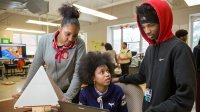Using Project-Based Learning to Immerse Students in Their Community
To create an authentic learning experience, teachers tasked high school students with designing museum exhibits that explore local history.
Your content has been saved!
Go to My Saved Content.At PSI High, our students make things—they’ve created instructional videos, mini-documentaries, video game soundtracks, and competition robots. Our curriculum is rooted in the philosophy of project-based learning.
When I was first introduced to the concept, there was a bit of a learning curve. How could I integrate required standards and balance time without creating a throwaway project? However, project-based learning has proven to be an effective pedagogical approach to increase student engagement, develop 21st-century skills, and scaffold learning to meet the distinct needs of all students.
Teachers at PSI High help students recognize real-world applications for the skills they develop through project creation. Finding a life or application for projects is a difficult hurdle even for seasoned PBL educators. The solution at PSI High lies in problem-based learning.
Implementing Design Thinking
John Larmer identifies how problem-based learning and project-based learning are “really two sides of the same coin.” Educators from all backgrounds can utilize both project- and problem-based learning to create an authentic learning experience and avoid the throwaway trap. This requires designing projects that address problems in the real world. To do so, we use design thinking, a methodology that uses cognitive strategies to identify and produce creative solutions.
First we engage in design thinking:
- Empathy: Who is this for, and what are their needs?
- Define: What is the problem? What is at stake?
- Ideate: What are we capable of developing?
Then, we build:
- Prototype: Mock-ups, samples, and ideas become tangible. The focus is interaction.
- Test: Take it out of the safe space. Get other hands and ideas involved, and attempt to identify additional needs.
A Micro Concept
Over the summer of 2021, educators at PSI High contemplated what all of our students in the program could create for the community of Sanford, Florida. Ultimately, we settled on a series of micromuseums that the students could construct across classes for the Sanford Museum. In our vision, students would choose their topics, communicate with the museum about exhibits, and design the structure itself. We believed our upper-class students could help lead our ninth graders as they navigated the project together.
In each phase of the design process, we mapped out crucial benchmarks for the students to engage in metacognitive exercises. These activities asked students to write, discuss, and think critically about the ideas they developed. The exercises reinforced the ethos of their project, while allowing us to include academic tasks that targeted key standards across the courses.
For the micromuseum builds themselves, students followed each of the design steps. One of the early problems we experienced was student apathy about Sanford overall. We wanted students to integrate more deeply with their community, but we also wanted them to have autonomy. How do you persuade teenagers to invest some semblance of emotion into their community when their two associations were its close proximity to Disney World and its being the place where Trayvon Martin was murdered?
To address the lack of enthusiasm among students, we enhanced our design thinking process to incorporate a distinct phase of thinking called iteration. We defined iteration as a process of revision where students learned from mistakes by returning to the beginning. Students investigated the history of Sanford by corresponding with key stakeholders (empathy). Here, students were beginning to learn more about the history of Sanford, growing curious about what they didn’t know.
Students didn’t know about Jackie Robinson coming to Sanford to play baseball, only to flee for his life to Daytona. They did not know that the Historic Goldsboro neighborhood was the second incorporated Black city in the United States. They were not aware of the catastrophic fire of 1887, nor of Henry Sanford’s lobbying efforts in the Belgian Congo, hoping that the Black Americans he dubbed the “black cloud” could be sent back.
Students were able to use this newfound knowledge about their community to envision the rest of the project. They drafted rationales identifying their audiences and constructed vision statements and research reports (define). They collaborated to create storyboards, 3D models, and videos that envisioned how the public would interact (ideate). As supplies were ordered, the teams constructed cardboard prototypes and presented them to a panel of administrators to receive crucial feedback.
So far, the project has been successful, if slightly chaotic. But the chaos is good. The students really started to get excited when sawdust began to blanket the floor of our main learning space. Best of all, through the students’ research into the history of their community, the problem became clear: How come we don’t learn about this in school?
When the students finish their models, they will roll them out to schools across the county to be tested by their peers. They’ll revise, polish, and then present at the Sanford Museum’s 65th anniversary in May 2022.
Return to Empathy
Our version of design thinking emphasizes iteration. Once students have created a product or service, they return to the first step of empathy. How will the audience experience the product? In our case, this prompted a series of questions related to the students’ learning experience: Can a micromuseum teach authentic histories? Can we make it accessible and entertaining for both children and adults? How do we reconcile with our community’s past?
Students must know that not all problems can be solved. We cannot ask students to solve the issues of climate change, systemic racism, and economic inequality on their own. Those are responsibilities shared by everyone. What we can do is localize the implications of these issues and foster stronger connections to our communities. Problem-based learning helps us provide students with these opportunities.
